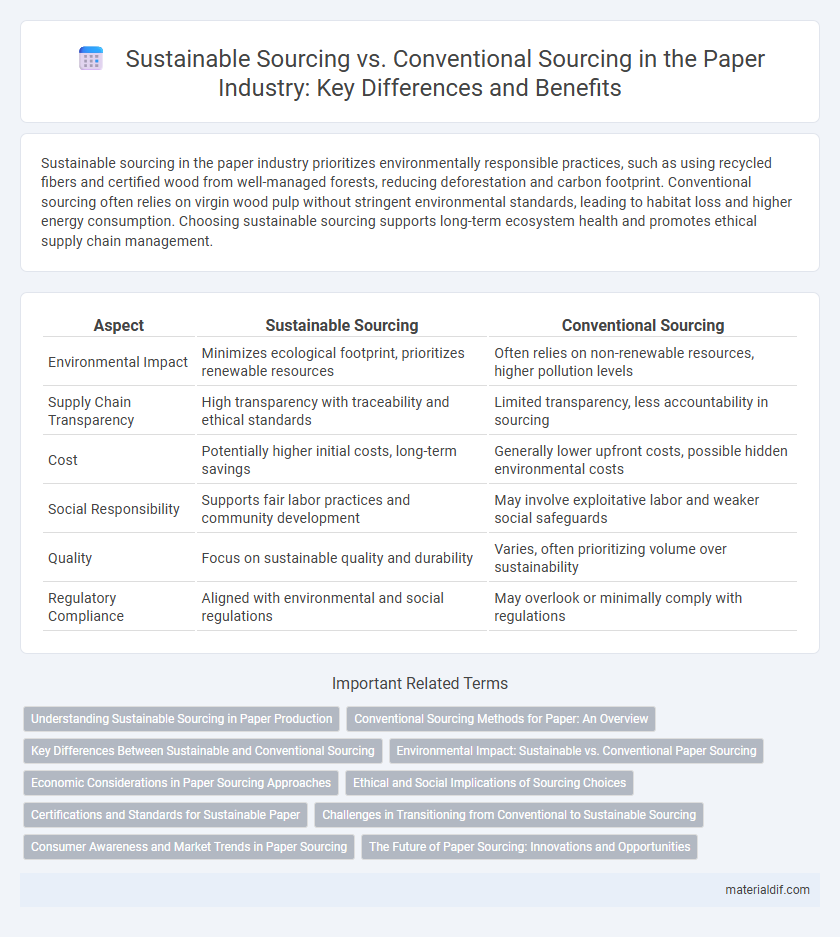Sustainable sourcing in the paper industry prioritizes environmentally responsible practices, such as using recycled fibers and certified wood from well-managed forests, reducing deforestation and carbon footprint. Conventional sourcing often relies on virgin wood pulp without stringent environmental standards, leading to habitat loss and higher energy consumption. Choosing sustainable sourcing supports long-term ecosystem health and promotes ethical supply chain management.
Table of Comparison
| Aspect | Sustainable Sourcing | Conventional Sourcing |
|---|---|---|
| Environmental Impact | Minimizes ecological footprint, prioritizes renewable resources | Often relies on non-renewable resources, higher pollution levels |
| Supply Chain Transparency | High transparency with traceability and ethical standards | Limited transparency, less accountability in sourcing |
| Cost | Potentially higher initial costs, long-term savings | Generally lower upfront costs, possible hidden environmental costs |
| Social Responsibility | Supports fair labor practices and community development | May involve exploitative labor and weaker social safeguards |
| Quality | Focus on sustainable quality and durability | Varies, often prioritizing volume over sustainability |
| Regulatory Compliance | Aligned with environmental and social regulations | May overlook or minimally comply with regulations |
Understanding Sustainable Sourcing in Paper Production
Sustainable sourcing in paper production emphasizes the use of raw materials from responsibly managed forests certified by organizations like FSC and PEFC, reducing environmental impact and promoting biodiversity. It prioritizes renewable resources, lifecycle assessment, and minimizing carbon footprint compared to conventional sourcing that often relies on unsustainable logging practices. Sustainable sourcing enhances long-term resource availability, aligns with corporate social responsibility goals, and supports eco-friendly production methods in the paper industry.
Conventional Sourcing Methods for Paper: An Overview
Conventional sourcing methods for paper predominantly rely on harvesting virgin wood fibers from natural forests, often leading to deforestation and biodiversity loss. These practices involve intensive use of chemical bleaching agents and high energy consumption, contributing to environmental pollution and increased carbon emissions. Despite efficiency in meeting global demand, conventional sourcing lacks the sustainability measures critical for long-term ecological balance.
Key Differences Between Sustainable and Conventional Sourcing
Sustainable sourcing prioritizes environmental conservation and social responsibility by selecting suppliers who adhere to ethical labor practices and minimize ecological impact, unlike conventional sourcing which primarily focuses on cost efficiency and supply reliability. Key differences include the integration of lifecycle assessments and carbon footprint evaluations in sustainable sourcing, whereas conventional sourcing often neglects these factors. Sustainable sourcing also emphasizes transparency and long-term supplier collaboration, contrasting with the transactional nature of conventional sourcing relationships.
Environmental Impact: Sustainable vs. Conventional Paper Sourcing
Sustainable paper sourcing significantly reduces environmental impact by prioritizing responsibly managed forests, minimizing deforestation, and promoting biodiversity conservation with certifications like FSC and PEFC. Conventional sourcing often leads to higher greenhouse gas emissions, increased water pollution, and habitat destruction due to clear-cutting and unsustainable harvesting practices. Lifecycle assessments show sustainably sourced paper has a lower carbon footprint and better supports ecosystem health compared to conventional alternatives.
Economic Considerations in Paper Sourcing Approaches
Sustainable sourcing in paper production often involves higher upfront costs due to certification processes like FSC or PEFC, but it can lead to long-term savings through improved resource efficiency and reduced environmental penalties. Conventional sourcing typically offers lower immediate expenses by relying on cheaper, non-certified raw materials, yet it exposes companies to risks such as supply chain disruptions and fluctuating raw material prices driven by unsustainable practices. Economic considerations must weigh immediate cost advantages against the potential for enhanced brand value, regulatory compliance, and market access associated with sustainably sourced paper products.
Ethical and Social Implications of Sourcing Choices
Sustainable sourcing promotes ethical labor practices and reduces environmental impact by prioritizing suppliers committed to fair wages, safe working conditions, and minimal ecological footprint. Conventional sourcing often overlooks these social responsibilities, leading to exploitative labor, unsafe environments, and negative community consequences. Choosing sustainable sourcing supports long-term social equity and corporate responsibility, crucial for modern ethical supply chains.
Certifications and Standards for Sustainable Paper
Sustainable paper sourcing prioritizes certifications such as FSC (Forest Stewardship Council) and PEFC (Programme for the Endorsement of Forest Certification), which ensure responsible forest management and traceability throughout the supply chain. These standards mandate reduced environmental impact, conservation of biodiversity, and social responsibility, contrasting conventional sourcing that often lacks such rigorous environmental criteria. Sustainable certifications promote transparency and accountability, driving industry-wide adoption of eco-friendly practices and reducing deforestation linked to paper production.
Challenges in Transitioning from Conventional to Sustainable Sourcing
Transitioning from conventional to sustainable sourcing presents challenges such as higher initial costs, supply chain complexity, and supplier compliance verification. Companies often face difficulties in identifying reliable suppliers that meet sustainability criteria and in integrating sustainable practices without disrupting existing operations. Furthermore, limited transparency and inconsistent sustainability standards hinder effective monitoring and reporting during the transition phase.
Consumer Awareness and Market Trends in Paper Sourcing
Consumer awareness of sustainable sourcing in the paper industry has significantly increased, driven by growing environmental concerns and demand for eco-friendly products. Market trends indicate a shift toward certified sustainable paper sources such as FSC and PEFC, which ensure responsible forest management and reduce ecological impact. Conventional sourcing remains prevalent but faces decreasing market share as transparency and sustainability become critical factors in consumer purchasing decisions.
The Future of Paper Sourcing: Innovations and Opportunities
Sustainable paper sourcing prioritizes renewable forest management, reducing carbon emissions, and minimizing water usage compared to conventional methods reliant on clear-cutting and chemical-intensive processes. Innovations like recycled fiber technology, alternative raw materials such as agricultural residues, and blockchain for supply chain transparency are transforming future paper production. Opportunities lie in aligning industry practices with circular economy principles to meet increasing demand while preserving ecosystems and enhancing social responsibility.
Sustainable Sourcing vs Conventional Sourcing Infographic

 materialdif.com
materialdif.com